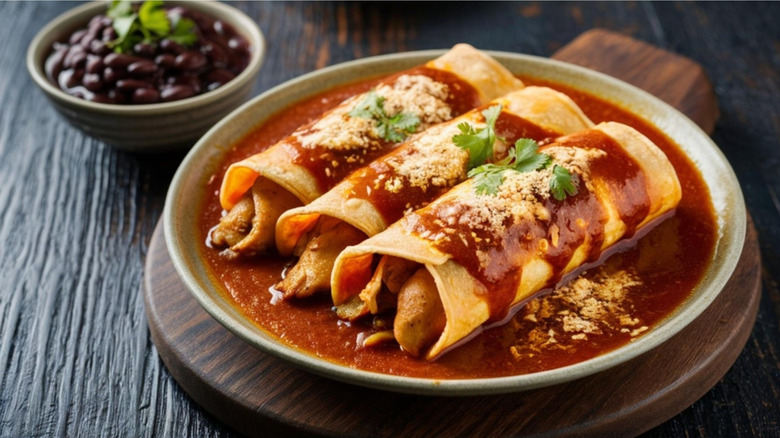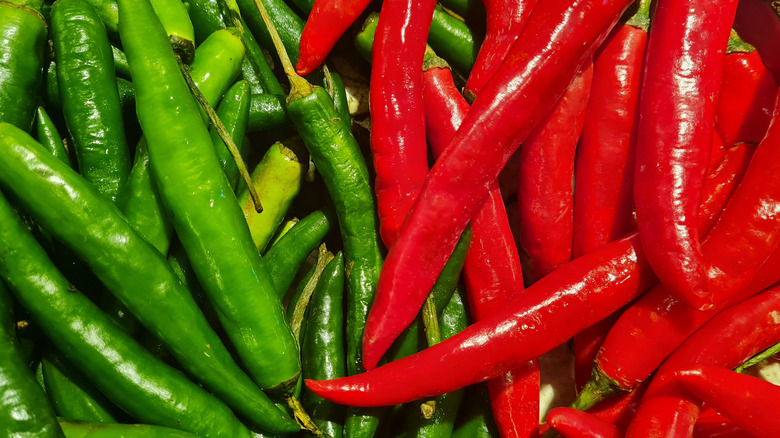How Does The Cuisine Differ In New Mexico Vs Mexico?
When you walk into a Mexican restaurant anywhere in the United States, there is a good chance that you might not be getting authentic Mexican food. What you may actually encounter are Tex-Mex style dishes with New Mexican influences. While it may take a minute to recognize the differences between the two cuisines, there are many distinct characteristics that distinguish New Mexican food from traditional Mexican food.
Traditional Mexican food dates back thousands of years, with deep roots stemming from ancient Mayan and Aztec civilizations. These groups utilized staples like corn, beans, and chiles in many of their dishes. Spanish influences later introduced elements like meat and dairy. New Mexican food, on the other hand, derives from the diets of Native American tribes. Early forms of the cuisine incorporated foods similar to Mexican cuisine like corn, beans, squash, and pine nuts in the entrees, although the style of food preparation was unique to the New Mexico region.
While the two cuisines do share many similarities, New Mexican food has become a distinctly different kind of cuisine from traditional Mexican food over time. Modern New Mexican cuisine is also considered a subsection of Tex-Mex food, which is considered a Mexican-inspired cuisine with Americanized influences.
The two cuisines have some very different entrees
Many of the entrees that you likely associate with Mexican food might actually have originated in America. Foods like nachos, fajitas, burritos, and certain types of enchiladas are all dishes that define Tex-Mex and New Mexican cuisine. The typical side of rice and beans that accompanies many of these dishes are also not actually native to traditional Mexican food. Authentic Mexican dishes will more often offer a choice of corn or roasted vegetables on the side.
There are many dishes that are enjoyed by both cuisines, such as tacos and quesadillas. However, there are important regional distinctions between how the foods are prepared. For example, most traditional Mexican-style quesadillas will use Oaxaca cheese or chihuahua cheese, whereas quesadillas in Tex-Mex joints will often use Monterey or Colby Jack cheeses. Tacos are most commonly filled with ground beef, steak, or pork in Mexican cuisine, while New Mexico natives enjoy experimenting with flavor fusions — it's not uncommon for the stateside restaurants to offer tacos filled with seafood or a scramble of eggs and bacon. Breakfast burritos are another classic New Mexican food that you might not be able to find anywhere South of the border.
Chiles play an important role in New Mexican food
The use of chiles is another way to distinguish whether or not a dish is inspired by New Mexican cuisine. While Mexican foods utilize a wide variety of spices and herbs, red and green chiles are quintessentially New Mexican. The state itself is known as the chile capital of the world, and utilizes the locally sourced ingredient to turn up the heat in practically all New Mexican-style dishes.
It's not uncommon for chiles to be blended up into red and green sauces and lathered onto everything from burritos to buñuelos. However, this does not mean that New Mexican food is spicier than Mexican food. On the contrary, Mexican food tends to utilize spices like cumin and ground chili peppers, which provide a rich blend of heat and flavor to various meats, vegetables, and salsas.
Corn versus flour tortillas
You aren't likely to find any flour tortillas at an authentic Mexican restaurant. Corn tortillas are utilized almost exclusively in Mexican food, encasing everything from tacos to enchiladas and flautas. New Mexican style food, however, favors the fluffy, bread-like texture of a flour tortilla. You will often be offered a choice of corn or flour tortillas at most New Mexican or Tex-Mex style restaurants.
And even the corn tortillas are used differently in New Mexico. Unlike the warm yet soft street taco tortilla that is common in Mexican cuisine, the New Mexican style of cooking calls for a corn tortilla to be fried in oil until it becomes a firm, crispy shell. This is known as a hard shell taco, which is native to the Americanized Mexican fusion cuisine. New Mexican cuisine might also ditch the tortilla all together in favor of Navajo tacos, which use fry bread as a base for all of the taco toppings that your heart desires — although the final product more closely resembles a tostada than a taco.
Toppings often give away which cuisine you are enjoying
One of the biggest ways you can distinguish between Mexican and New Mexican cuisine is whether or not your dish comes with a cheese pull. While Mexican food may use a sprinkle of white Oaxaca cheese or queso fresco on top of a taco every now and then, the introduction of yellow cheese into Mexican food is a very American thing. In fact, many of the dips and sauces that are commonly associated with Mexican food, such as chili con queso and nacho cheese, aren't offered at most authentic Mexican restaurants.
Surprisingly, the crunchy tortilla chips that are used to scoop up these cheesy dips are also a Tex-Mex creation. Authentic Mexican food more often offers diners fresh tortillas on the side instead of tortilla chips. Other toppings that are utilized in New Mexican food includes sour cream, shredded lettuce, and diced tomatoes. Mexican food will more often use toppings like crema, sliced radish, fresh pico de gallo, and a squeeze of lime juice depending on the dish.
Both styles of food offer delicious yet very different desserts
Whether you are enjoying traditional Mexican food or a fusion of flavors at a Tex-Mex-style joint in New Mexico, be sure to save room for dessert. Desserts native to Mexico include flan, tres leches cake, and churros. New Mexican style restaurants, on the other hand, typically offers a New Mexican invention called sopaipillas. This dessert consists of a sweet dough that has been fried, dusted with cinnamon sugar and drizzled with honey.
From appetizers to dessert, clearly there are many drastic differences between Mexican food and New Mexican food. But the question of which is better ultimately boils down to personal preference: Do you enjoy your tacos encased in a soft, flour shell and stuffed with cheese, or is the classic street taco the style you crave again and again? Fortunately, the two cuisines have long been in conversation with one another, so we do not often have to choose between queso and fresh salsa for the table — Por qué no los dos?






